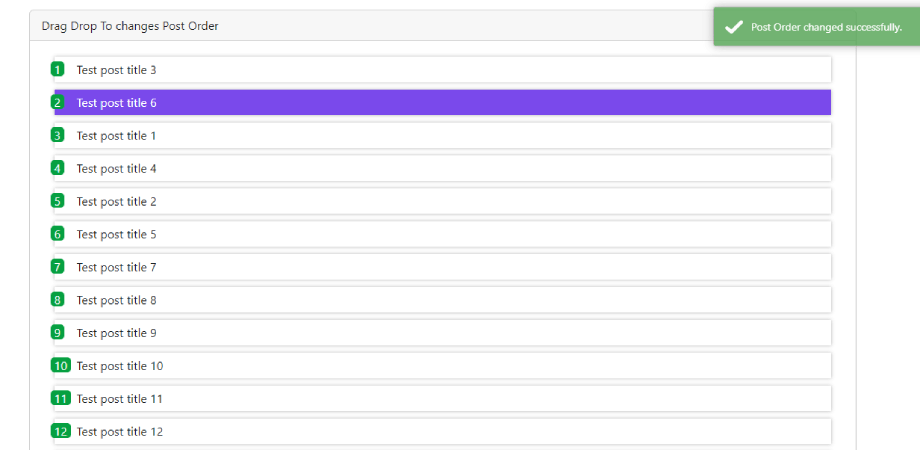Top useful WordPress functions list and examples
WordPress functions list:
- the_post()
- have_posts()
- the_title()
- get_the_title()
- has_post_thumbnail()
- the_post_thumbnail()
- get_the_post_thumbnail()
- the_content()
- the_date() vs get_the_date( )
- the_time() vs get_the_time()
- comments_number(); vs get_comments_number()
- get_comments_number_text()
- comments_template()
- comments_open()
- comment_date( ) vs get_comment_date()
- comment_time( ) vs get_comment_time()
- wp_list_comments()
- comment_author()
- comment_form()
- wp_dashboard_recent_comments()
- get_avatar()
the_post()
Check if the loop has started and configure the next post to be displayed with each iteration within the loop.
<?php
if ( have_posts() ) :
while ( have_posts() ) : the_post(); ?>
<h2><?php the_title(); ?></h2>
<?php
// Check if the post has a featured image
if ( has_post_thumbnail() ) {
the_post_thumbnail(); // Display the featured image
}
?>
<div><?php the_content(); ?></div>
<p>Posted on: <?php the_date(); ?> at <?php the_time(); ?></p>
<p>Comments: <?php comments_number(); ?></p>
<p>Author: <?php the_author(); ?></p>
<?php endwhile;
endif;
?>
the_date() vs get_the_date( )
the_date() function retrieves the date and display of the current post.
get_the_date( ) function is used to get the date of the current post and returns a string.
<?php
the_date();
the_date('F j, Y');
//display the custom date formate
echo get_the_date();
echo get_the_date('F j, Y');
the_time() vs get_the_time()
the_time() function retrieves the time and display of the current post.
get_the_time( ) function is used to get the time of the current post and returns a string.
<?pph
the_time();
echo the_time('F j, Y g:i a');
echo get_the_time();
echo get_the_time('F j, Y g:i a');
?>
comments_number(); vs get_comments_number();
comments_number() function retrieves the total comment number of the current post and displays it.
get_comments_number( ) function is used to get the total comment number of the current and returns a string.
<?php
comments_number();
echo get_comments_number()
?>
get_comments_number_text()
This function is used to generate a human-readable string that describes the number of comments on a post.
<?php
$comments_text = get_comments_number_text('No Comments', '1 Comment', '% Comments');
echo $comments_text;
?>
comments_template()
comments_template() function is used to include the comments template file in the current post single page. This function is always placed within the loop to display the comments section for a post.
<?php
if ( have_posts() ) :
while ( have_posts() ) : the_post();
// Your post content goes here
the_title();
the_content();
// Include the comments template
comments_template();
endwhile;
endif;
?>
comments_open()
comments_open() function is used to check whether the comments are open or not in WordPress settings for a particular post or page. It returns a boolean value: true if comments are open, and false if comments are closed.
<?php
if ( comments_open() ) {
// Display your comments section or comment form here
} else {
// Comments are closed, handle accordingly
}
?>
comment_date( ) vs get_comment_date()
comment_date() function retrieves and displays the comment date of the current comment.
get_comment_date( ) function is used to get the comment date of the current comment and returns a string.
<div>Comment posted on <?php comment_date(); ?></div>
<div>Comment posted on <?php comment_date('M j, Y, g:i a'); // Mar 10, 2023, 6:10 pm ?></div>
<div>Comment posted on <?php echo get_comment_date(); ?></div>
<div>Comment posted on <?php echo get_comment_date('M j, Y, g:i a'); // Mar 10, 2023, 6:10 pm ?></div>
comment_date( ) vs get_comment_date()
Displays the comment date of the current comment.
comment_time( ) vs get_comment_time()
comment_time() function retrieves and displays the comment time of the current comment.
get_comment_time( ) function is used to get the comment time of the current comment and returns a string.
<?php comment_time(); ?>
<?php
$comment_time = get_comment_time('U'); // 'U' returns the Unix timestamp
echo date('F j, Y g:i a', $comment_time);
?>
wp_list_comments()
<ol class="comment-list">
<?php wp_list_comments(); ?>
</ol>
// or we can pass the argument to the output comment
<?php
$args = array(
'walker' => null,
'max_depth' => '',
'style' => 'ol', // or 'ul' for unordered list
'callback' => null,
'end-callback' => null,
'type' => 'all',
'reply_text' => 'Reply',
'page' => '',
'per_page' => '',
'avatar_size' => 32,
'reverse_top_level' => null,
'reverse_children' => '',
'format' => 'html5', // or 'xhtml' for XHTML doctype
'short_ping' => false,
'echo' => true, // Whether to echo the list or return it
);
wp_list_comments($args);
?>
comment_author()
The comment_author() function retrieves and displays the name of the author for the current comment.
<div>Comment by <?php comment_author(); ?>:</div>
Above is a traditional way to itrate loop we can also run a loop using curly braces
<?php
if ( have_posts() ){
while ( have_posts() ) {
the_post(); ?>
<h2><?php the_title(); ?></h2>
<?php
// Check if the post has a featured image
if ( has_post_thumbnail() ) {
the_post_thumbnail(); // Display the featured image
}
?>
<div><?php the_content(); ?></div>
<p>Posted on: <?php the_date(); ?> at <?php the_time(); ?></p>
<p>Comments: <?php comments_number(); ?></p>
<p>Author: <?php the_author(); ?></p>
<?php };
};
?>
comment_form()
The comment_form() function is used to display an HTML comment form inside a WordPress template file.
<?php
$args = array(
// Change the title of send button
'label_submit' => __( 'Send', 'textdomain' ),
// Change the title of the reply section
'title_reply' => __( 'Write a Reply or Comment', 'textdomain' ),
// Redefine your own textarea
'comment_field' => '<div class="comment-fields"><label for="comment">' . _x( 'Comment', 'noun' ) . '</label><br><textarea id="comment" name="comment" required> </textarea> </div>'
);
comment_form( $args ); ?>
wp_dashboard_recent_comments()
The wp_dashboard_recent_comments() function is used to output the list of recent comments in the WordPress dashboard. It is typically used in the dashboard to provide administrators with a quick overview of the latest comments on their site.
<?php
// Display recent comments on the WordPress dashboard
wp_dashboard_recent_comments();
?>
get_avatar()
The get_avatar() function is used to fetch the avatar (profile picture) of a user. It's commonly used to display user avatars in comments, author boxes, or anywhere else user information is displayed.
<?php echo get_avatar( get_the_author_meta( 'ID' ), 48 ); ?>
have_posts()
have_posts() function is often used in the context of a loop to check whether there are any posts to be displayed.
<?php
if (have_posts()) {
// There are posts to display
while (have_posts()) {
the_post();
// ... Display post content here
}
} else {
// There are no posts to display
// ... Display a message or alternative content
}
?>
the_title()
the_title() function is used to display the title of the current post within the loop.
<?php the_title(); ?>
get_the_title()
The get_the_title() function retrieves the title of the current post and returns a string in the loop.
<?php echo get_the_title(); ?>
has_post_thumbnail()
has_post_thumbnail() function is used to check if the current post has a (post thumbnail (featured image)
if ( has_post_thumbnail() ) {
the_post_thumbnail();
}
else {
echo '<img src="' . get_template_directory_uri( ) . '/images/default-thumbnail.jpg">';
}
the_post_thumbnail()
This function is used to display the feature image or thumbnail image in blog or shop page
<?php the_post_thumbnail(); ?>
<?php
//Default WordPress
the_post_thumbnail( 'thumbnail' ); // Thumbnail (150 x 150 hard cropped)
the_post_thumbnail( 'medium' ); // Medium resolution (300 x 300 max height 300px)
the_post_thumbnail( 'medium_large' ); // Medium Large (added in WP 4.4) resolution (768 x 0 infinite height)
the_post_thumbnail( 'large' ); // Large resolution (1024 x 1024 max height 1024px)
the_post_thumbnail( 'full' ); // Full resolution (original size uploaded)
//With WooCommerce
the_post_thumbnail( 'shop_thumbnail' ); // Shop thumbnail (180 x 180 hard cropped)
the_post_thumbnail( 'shop_catalog' ); // Shop catalog (300 x 300 hard cropped)
the_post_thumbnail( 'shop_single' ); // Shop single (600 x 600 hard cropped)
get_the_post_thumbnail()
It retrieves the post thumbnail and returns string if you want to display you have to echo it
<?php echo get_the_post_thumbnail(); ?>
<?php
echo get_the_post_thumbnail( get_the_id(), 'thumbnail', array( 'class' => 'align-right' ) );
?>
the_content()
the_content() function is used to display the post content inside the loop
<?php the_content(); ?>


